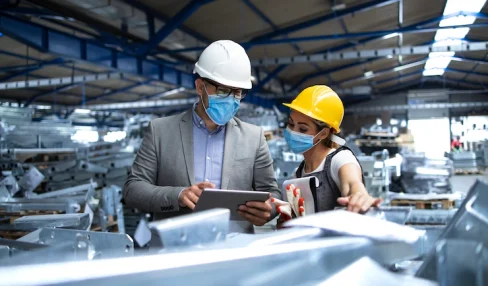What Makes a Shared Office Space Truly “Professional”?
09 April 2025
5 Mins Read

toc impalement
As the nature of work continues to evolve, so does our perception of what constitutes a professional environment.
We will explore how shared office spaces redefine the traditional markers of professionalism and offer new ways to support productive, focused, and client-ready workdays.
Previously, a professional office was often associating with private corner suites, large desks, and uniform dress codes.
Today, businesses are increasingly drawn to sharing workspaces because they are convenient or affordable and provide well-round, flexible environments.
From sleek design to thoughtful amenities, these spaces are shaping the future of professionalism in real time. It’s not just about formality or silence—it’s about efficiency, adaptability, and atmosphere.
A professional sharing office isn’t simply where work gets done; teams thrive, clients feel welcome, and daily operations are streamlining through innovative design, support services, and technology that meet modern expectations.
Redefining Professionalism in the Modern Workplace
To be a Professional in a workplace, it means that the employees should have the following;
- Excel in skills, knowledge, ans the behavioral development required for that specific role.
- Going above and beyond in their respective job roles and other duties.
- Able to deliver any assigned work to the best of their abilities within the deadline.
- Constantly on the lookout for growth opportunities to improve themselves within the organization.
Design and Layout That Encourage Focus and Confidence
One of the defining traits of a genuinely professional shared office space is its physical environment. The layout, furniture, and lighting all play a critical role in shaping how people feel when they enter and how well they can concentrate throughout the day.
This means balancing open areas with private corners, providing soundproof rooms for calls or meetings. At the same time, integrating ergonomic furniture that supports long, productive work hours in shared spaces.
Professional doesn’t have to mean cold or corporate. Many modern offices incorporate natural lighting, greenery, and thoughtful décor to make people feel comfortable without losing their sense of purpose.
Functionality is key: clean, clutter-free surfaces, easy-to-navigate walkways, and well-maintaining common areas signal that space is taken seriously. Clients, too, notice these details.
Whether it’s a polished waiting area or a clean restroom. These subtle touches speak volumes about the standards of the businesses operating within the space. Confidence and productivity tend to follow in environments that look and feel organized.
Services That Reflect Business Needs
Beyond physical aesthetics, its services elevate a shared office into a professional setting. High-speed internet is now a given, but other services—like printing, mail handling, reception support, and access to fully equipping the conference rooms—are still needed. This signals that the space is designed with real business in mind.
These offerings make a difference when hosting meetings, onboarding new employees, or preparing materials for a pitch. When services are seamless, tenants can focus on their goals instead of logistics.
A space that consistently offers these conveniences creates an environment where work feels uninterrupting and smooth. Administrative and technical support can also enhance professionalism.
When on-site teams are available to handle IT issues, greet guests, or manage deliveries, businesses gain a sense of stability and credibility.
These support layers often mirror what’s found in traditional office settings but within a more flexible and frequently collaborative context that suits companies in all growth phases.
A Culture of Courtesy and Professional Behavior
No matter how well-design a workspace is, it will only feel professional if the people inside it maintain a culture of respect and courtesy.
Shared office spaces are unique in that they bring together a variety of businesses, freelancers, and remote teams, often working on very different projects.
Despite these differences, maintaining a shared understanding of professional behavior is crucial. This includes keeping phone conversations at a reasonable volume, respecting shared resources, and cleaning up after oneself in common areas.
While these may seem small, they make a big difference in maintaining a respectful, distraction-free environment.
Furthermore, when a community is built around mutual respect, networking becomes easier, collaboration feels more natural, and even casual conversations create a sense of productive engagement.
Culture cannot incorporate into a space—it must nurture by the people who use it. In that sense, the professionalism of a shared office is just as much about behavior as it is about appearance.
Location and Accessibility for Daily and Client Use
A professional office doesn’t only serve internal staff—it must also make an impression on visitors. Location plays a significant role in how a sharing office is perceiving.
Is it centrally located, easy to find, and accessible by public transit or parking? These details matter when clients or collaborators are visiting.
A high-quality Shared Office Space in Jersey City, NJ, might provide easy access to business districts while offering scenic views, ample transportation options, and nearby amenities that contribute to a polished image.
For team members, convenience can translate to better morale and more time spent focusing on meaningful tasks rather than stressful commutes.
From exterior signage to how smoothly greeting and directing visitors, everything about the space communicates something about the businesses it houses.
A shared office that supports daily functionality while projecting professionalism outward becomes an asset for workflow, brand image, and client relationships.
Security, Cleanliness, and Consistent Standards
What often separates a casual workspace from a professional one is reliable security and consistent upkeep. People must feel safe leaving their equipment overnight or discussing sensitive topics privately.
Controlling access points, surveillance cameras, and secure storage options help reinforce trust in the physical environment. Cleanliness also significantly impacts the perception of the space.
Regular cleaning of common areas, sanitization stations, and maintenance schedules show a commitment to high standards and attention to detail. These aren’t just cosmetic features—they affect how confidently people can work and host others.
The predictability of high standards also helps with productivity. When a space consistently functions well and is maintained with care, it removes friction from daily routines.
Final Thoughts!
Employees and clients alike can sense when a workspace is well-manage. This perception contributes significantly to a professional experience that builds trust and encourages ongoing engagement.
A professional shared office space define by sleek chairs and fast Wi-Fi. It’s about creating an environment that supports focus work, reflects a company’s values, and fosters a sense of credibility for anyone who walks through the door.
From thoughtful layout design to dependable services and respectful community norms. Every element plays a part in establishing what “professional” means in a modern context.
As shared offices grow in popularity, those that go beyond convenience to offer actual functionality and presence will stand out. These spaces aren’t just where people sit and work—they’re where idea pitching is important, businesses grow, and trust is built.
This is for professionals looking to make the right impression while staying agile in a changing work landscape. A shared office that feels truly professional aligns with the rhythm and standards of their work—not just its appearance.
READ MORE:

















